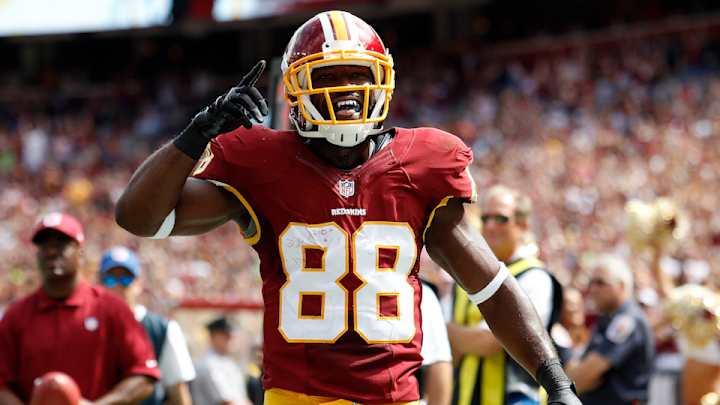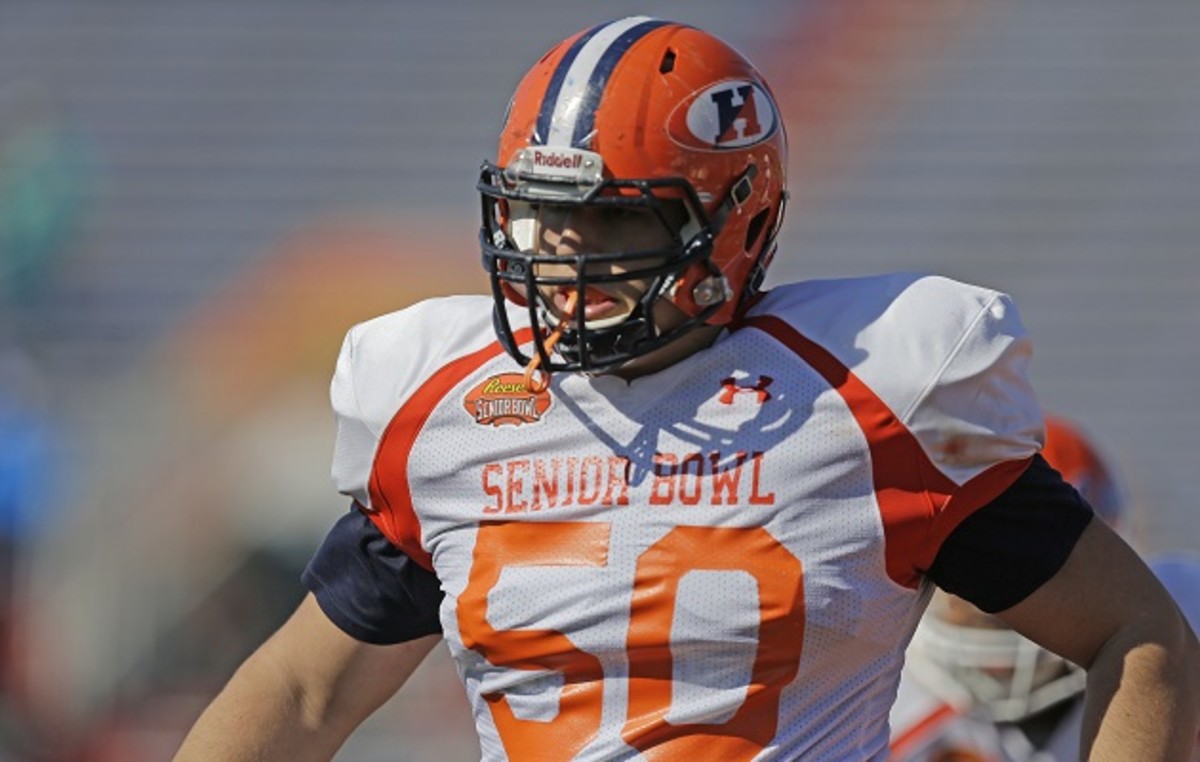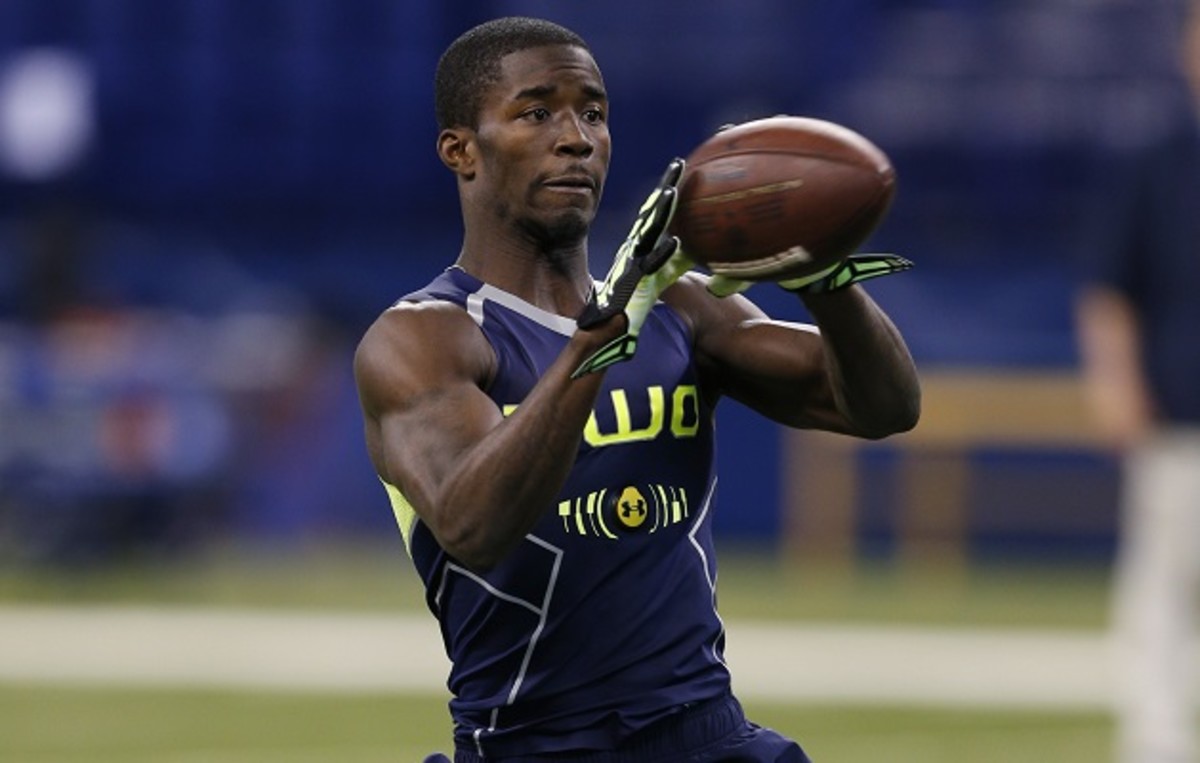What it's like to jump from Division II/III to the NFL

When the 2016 NFL draft begins on Thursday, North Dakota State quarterback Carson Wentz will likely be among the first players selected.
Wentz is a rarity: He played college football in the Football Championship Subdivision, which has produced only 12 first–rounders since 1985. But while FCS offers less exposure than the top flight of college football, it's still a bigger stage than Division II or Division III.
What is it like trying to break onto an NFL roster from relative obscurity? We talked to three active players—Ali Marpet, Pierre Garcon and John Brown—about their experiences transitioning from Division II/III to the NFL.
Marpet is a starting offensive guard for the Tampa Bay Buccaneers and is the highest-drafted Division III player ever. He was taken with the 61st pick out of Hobart in the 2015 draft.
Garcon has been a solid contributor at receiver throughout his eight-year NFL career with the Indianapolis Colts and Washington Redskins, hauling 485 receptions for 6,027 yards and 34 touchdowns. His 113 receptions with the Redskins in 2013 is the franchise single-season record. Garcon attended Division III Mount Union.
Brown, who starred at Division II Pittsburg State, had his breakout season at receiver with the Arizona Cardinals in 2015, recording 1,003 receiving yards and seven touchdowns in 15 games.
Note: These interviews have been edited and condensed for clarity.
Sports Illustrated:What was the first point in your college career that a future in the NFL began to look like a real possibility?
OG Ali Marpet, Tampa Bay Buccaneers (Hobart College - Division III): It was probably my junior year. I was blessed to have national scouts come by. So I ran the 40 for them, took some measurements, did a Wonderlic test, and from there they actually gave me a grade that was like a priority free agent grade, which seemed pretty cool at the time. From there, that evoked enough interest to have scouts come by throughout my senior season.
WR Pierre Garcon, Washington Redskins (Mount Union - Division III): We had a scout come out in the spring to time us in the 40. It was after our junior year and we had won a national championship. I was like, oh man, this might be an opportunity, because they’re sending the scout to check us out. This is the first hint of possibility that this can happen and you’re on the NFL’s radar. The rule in football is, if you’re good they’ll find you. So we always stuck to that, and we went into senior year playing hard, doing well and trying to make it to the NFL.
WR John Brown, Arizona Cardinals (Pittsburg State - Division II): I would say after my sophomore year, that was my breakout season at Pitt. That’s when I had scouts start to come out and watch me for the first time.
SI:Did you ever have thoughts that playing at Division II or Division III would hold you back, or consider transferring to a DI school?
AM: I was a captain for my junior year, so I wasn’t going to leave for my senior year to try and play somewhere else. But, yeah, obviously it was always a concern because it’s difficult to evaluate my senior year as a player because I’m not going against that top–level competition. But, it never really crossed my mind to transfer for that reason.
PG: Well, when I was transferring from Norwich [University] to Mount Union I thought about transferring to DI, but they said I had to sit out a year. So I decided to transfer to Mount Union. Actually, a friend from my hometown went there and told me to go there. And I had never heard of Mount Union, didn’t know much about them. But he told me it was a great school, great coaches, great team, they win a lot. So, he just thought I’d fit in.
JB: That was the plan originally, to transfer to a DI school. But things just didn’t work out as planned. When I was at Coffeyville [Community College] we always had [scouts] there watching us. So, [Pittsburg State] just pulled me aside and told me they wanted to give me a full-ride.

SI:When you arrived at the Senior Bowl and were competing against players from Division I schools, how difficult was the transition and did Division II/III prepare you?
AM: We had a defensive end at Hobart who was defensive player of the year our senior year, led Hobart in career sacks. So, I was going against him a lot. There was a difference [in talent], but it wasn’t as big a difference as I thought it was going to be. The top guys at Division III schools really have a lot of ability. I mean, if you’re going to take the average it’s probably not the same, but the top guys definitely did prepare me.
PG: I got invited to the All-Star Game, did well there, got invited to the combine. There were just a lot of blessings that kept coming and I took advantage of them. That’s what I was really happy about. I didn’t regret anything that happened in the process leading up to the draft. You still know there’s no guarantee you’ll get drafted, but I was happy with whatever the outcome was because I put everything out there that I could do. It was a great experience, draft day came around and I wasn’t nervous because I wasn’t expecting to get picked. So, if something happened that was a bonus, just being able to be considered was joy for me. Coming from DIII, you’re just happy to be in consideration.
JB: No, it wasn’t that difficult, because I grew up playing against those guys that went to the DI schools. So, you know, I knew I was good enough to play with those guys.
SI:How was that first few months in an NFL camp? Was the transition a shock or were you able to ease into it?
AM: Oh no, it was a shock transition, I was thrown into it. But, I think I adjusted pretty quickly and improved a lot in a short amount of time. I think that, obviously, I didn’t have the technical tools that would make me successful in the NFL, but I definitely think I had athletic ability. From there, I was able to get coached up on and improve pretty much all aspects of the game.
PG: It was different. You know, football was the same, but it was just the terminology and making sure you were doing things right. Because you’re coming from a DIII and you’re not sure about everything. You’re just second guessing yourself instead of just playing football.
SI:In Division III, you’re limited on how much time you can spend playing football in the offseason. So what were you up to when you had to spend that time away from your team?
AM: Just because we didn’t have football, didn’t mean that it was easy. My spring ball was a nightmare as far as conditioning. Because we couldn’t play much football, all we did was conditioning and competing. I’m glad I don’t have spring ball any more, let’s just put it that way.

SI:What do you feel you gained most from playing at the Division II/III level?
AM: I went to Hobart for academics, and for that, not saying that guys who go to big schools are just going there for football, but I know that academics plays big role [in Division III]. One of the things I got out of that was just managing everything. You really do have to manage the balancing act of football and academics. That’s something I’ve taken away from my time at Hobart.
PG: At Mount Union, we were a winning team. A lot of guys had success on the football field. Because we were so talented, there were some games were I’d only catch one pass or two passes and we’d rush for 300 yards in the first half and be up by 52. But, we had to be a team player and do everything right. We had to block for the running backs, block for the other receivers on screens. It showed me how to be a team player and how to do well at everything.
JB: At a DI school you have 80,000 people watching your games, here you have like 15,000, 16,000. And the biggest thing at DII is you might not have the same facilities as those schools. But, playing there, you had to put in the work even if people aren’t looking at you.
SI:What do you think are the disadvantages for a football player coming out from the Division II or Division III level?
AM: The game is a little bit more simplified. I don’t know exactly what is taught at the Division I level, but again, I think my game was a little bit simplified as far as actual game planning that went into it, just because we can’t meet for that long. Another disadvantage, might be, again, not being able to play year–round.
PG: There is a different level of pressure. It’s like, oh man, I’m from Division III, I don’t think I belong here, I don’t think the coaches like me. I’m a sixth-round pick, they probably just had to make a pick. So, there was just a lot of insecurity about yourself and if you fit in. I put a lot of pressure on myself, but it was just all me mentally, trying to make sure I’m not doing the wrong thing instead of doing the right thing.
JB: I don’t really know the answer for that. But when I was at Pitt, I had great teammates and great coaches.
SI:Did you ever have people question your ability to play in the NFL because you came from such a small school?
AM: Yeah, I think so, but I think most of the people that were questioning it were just critics of the game, not real decision makers. But I’m sure there were decision makers that were probably a little afraid to draft a Division III player just because you never know how someone is going to deal with being on a bigger stage.
JB: Oh yeah, I definitely had people question me because I went to Pitt and played DII. There were people wondering if I could get off the ball and make plays. I also got questions about my size. But I just showed them that I had the work ethic to come and try my hardest every day.
SI:What piece of advice would you give to players from small schools entering the NFL?
AM: I guess something I can tell them is, hey, it doesn’t matter where you play ball, this is a whole 'nother game. So, you could be a star at, let’s say Florida State, but really it’s about production on the NFL field, not what you did in college.
PG: The advice that I would give is if there’s an opportunity, take advantage of it. If the pros want to see something, give it to them. If they’re at your game, take advantage of it, make every play count. If they want you to run the 40, run it. If they want you to run whatever drill do it to the best of your ability, because [scouts] are not always guaranteed to come back to your small school.
JB: I would say that you have to put in the work every day. It’s like they say, if you can play football they’ll find you. But, when you’re at school like Pitt, there aren’t scouts around all the time. When we heard that a scout would be there, we were at game speed the whole time.
